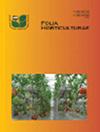南摩拉维亚(捷克共和国)气候条件下大黄类群和收获日期对 L-抗坏血酸和草酸含量的影响
IF 1.8
4区 农林科学
Q2 HORTICULTURE
引用次数: 0
摘要
大黄(Rheum L.)是一种著名的药用和烹饪植物。除了丰富的营养价值外,大黄还含有较高浓度的草酸盐。本研究评估了南摩拉维亚地区常规生产条件下,大黄基因库(捷克共和国莱德尼采)收集的 16 个大黄品种(Rheum rhabarbarum、R. rhaponticum 和 R. palmatum × wittrockii)在收获期的 L-抗坏血酸(AA)和草酸(OA)含量。左旋抗坏血酸是人体营养的必需品,而草酸被认为是有毒的,高剂量可能会导致严重的健康问题。研究人员对 AA 和 OA 含量、形态评估和基于 ISSR(简单序列间重复)的遗传分析进行了评估。研究结果证实,分类和采收时间对大黄的 AA 含量有显著影响。在采收季节(5 月)初期,AA 的含量为 6 毫克-100 克-1 至 10 克-100 克-1 鲜重(FW),采收期结束时,AA 的含量为 25 毫克-100 克-1 鲜重(FW)。OA 的含量变化很大,从 300 毫克-100 克-1 到 1800 毫克-100 克-1 鲜重不等。关于草酸盐的抗营养特性,该地区的最佳收获期估计为 5 月至 6 月初,此时 OA 含量最低。本研究结果并未证实 AA 是大黄中草酸盐形成的前体。本文章由计算机程序翻译,如有差异,请以英文原文为准。
Influence of Rheum taxa and harvesting date on the content of L-ascorbic acid and oxalic acid in the climatic conditions of South Moravia (Czech Republic)
Rhubarb (Rheum L.) is a well-known medicinal and culinary plant. Apart from its rich nutritional value, rhubarb contains a higher concentration of oxalates. In this study, the content of L-ascorbic acid (AA) and oxalic acid (OA) within three rhubarb species (Rheum rhabarbarum, R. rhaponticum and R. palmatum × wittrockii ) differentiated to 16 accessions in a gene bank rhubarb collection (Lednice, Czech Republic) in the condition of conventional production in the South Moravia region during the harvesting period was evaluated. While L-ascorbic acid is essential in human nutrition, oxalic acid is considered toxic, and high doses may cause serious health issues. AA and OA content, the morphology evaluation and ISSR (inter simple sequence repeats)-based genetic analysis were performed. The results of this study confirm the significant influence of taxonomy and harvesting time on the content of AA in Rheum accessions. The content of AA was determined from 6 mg · 100 g-1 to 10 g · 100 g-1 fresh weight (FW) at the beginning of the harvesting season (May) up to 25 mg · 100 g-1 FW at the end of the harvesting period. The content of OA strongly varied from 300 mg · 100 g-1 to 1800 mg · 100 g-1 FW. Regarding the antinutrient character of oxalate, the optimal harvest period of this region was estimated to be from May to early June, when the OA content was the lowest. The role of AA as a precursor of oxalate formation in rhubarb was not affirmed by the results of this study.
求助全文
通过发布文献求助,成功后即可免费获取论文全文。
去求助
来源期刊

Folia Horticulturae
Agricultural and Biological Sciences-Horticulture
CiteScore
3.40
自引率
0.00%
发文量
13
审稿时长
16 weeks
期刊介绍:
Folia Horticulturae is an international, scientific journal published in English. It covers a broad research spectrum of aspects related to horticultural science that are of interest to a wide scientific community and have an impact on progress in both basic and applied research carried out with the use of horticultural crops and their products. The journal’s aim is to disseminate recent findings and serve as a forum for presenting views as well as for discussing important problems and prospects of modern horticulture, particularly in relation to sustainable production of high yield and quality of horticultural products, including their impact on human health.
 求助内容:
求助内容: 应助结果提醒方式:
应助结果提醒方式:


